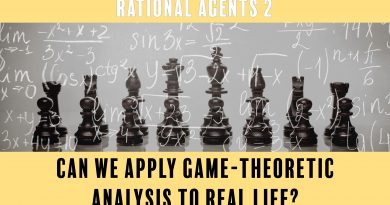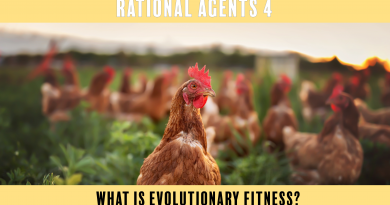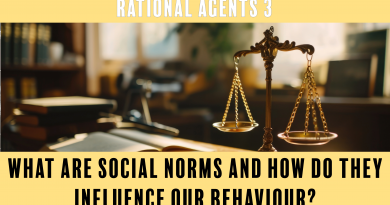When is a bias useful?
1. Introduction
Human decisions often deviate from the prescriptions of rational choice theory. Psychologists and behavioral economists usually explain this deviation with biases, which are mental patterns or heuristics causing incorrect inferences and irrationality, especially when relying on fast thinking and intuitions (cf. Kahneman 2012, p. 19).
Biases are a vibrant area of research. Consequently, there is a growing interest in making people better – especially among governments and well-meaning social engineers – by tackling these biases through interventions such as nudging (cf. Thaler & Sunstein 2009, p. 12 -15). But: Researching biases is anything but easy. The most popular book on biases is Nobel Prize winner Daniel Kahnemann’s Thinking Fast and Slow – but it is itself strongly affected by biases. Only 12% to 42% of the studies on which the book is based on, are replicable – the majority of the book has not survived the replication crisis very well and can be considered a victim of publication biases among others (cf. Schimmack 2020). The tricky thing is that the blind spot bias leads to a tendency to not to be able to recognize biases and their effects in ourselves as reliable as we can do in other people, even if we are aware of their existence (cf. Pronin et al. 2002).
Some biases certainly aren’t very useful nor adaptive, such as the exponential growth bias – which describes the tendency, even among trained professionals, to systematically fail to grasp and predict exponential growth (cf. Schonger & Sele 2021).
However not all what is called bias and is judged to cause irrational behavior, is always maladaptive or harmful. On the contrary, depending on the context, some biases can be seen as adaptive and/or useful traits, which enable more rational human behavior.
I will present three lines of argument as to why and when biases can be classified as useful or adaptive.
2. Arguments for biases to be in fact adaptive and useful traits
2.1. Who is the agent?
Before judging whether a bias is beneficial or maladaptive, one must answer for whom? Who is the agent to be evaluated? It is not the ideal, perfectly rational agent from models of rational choice theory – but is it the human?
When we evaluate human decisions and the effects of biases, we tend to judge them in relation to the acting individual and her preferences. We assume that the agent whose rationality is to be evaluated is an individual. This approach itself seems to be the biased result of our tendency to ascribe agency primarily to individuals, and to assume that the conscious ‘I’ is the agent our cognitive faculties have developed and are supposed to serve. This isn’t necessarily the case.
For one, the human psyche seems not to be a single, unified agent, but rather the result of the collective choice of countless cells and cellular systems with divergent preferences, which the conscious ‘I’ for the most part isn’t even aware of (cf. Ciauncia et al. 2023). From the perspective of biology, one has to ask, whether what we call a human is not merely the principal for a collective of cells.
Second: Humans are the result of evolution and therefore selection, and selection doesn’t care about individual preferences. While genes don’t really have preferences as they are not agents, they do have characteristics, which are the result of successful reproduction, and in a metaphorical way they are designed for and have an interest in replication, and the principal they use to pursue this interest, is the individual (cf. Joyce 2006, p.15).
From this perspective our cognitive abilities didn’t evolve primarily to serve the personal preferences of individuals, but to serve the genetic interest to survive for propagation. Personal and genetic interests are not perfectly aligned, and they are not identical (cf. ibid.).
One could postulate, that sometimes biases serve the purpose of nudging an individual to make irrational decisions against her personal preferences, but for the benefit of genetic interest. In such cases the bias can be called an evolutionary adaptive trait.
Some sexist biases seem to fall into this category. The women-are-wonderful effect is a bias causing people to associate more positive attributes with women when compared to men, contributing to irrational decisions e.g., in courts, where woman tend to receive much shorter prison sentences than men for committing the same crime (cf. Barreto & Doyle 2022, pp. 99, 105). Women are more important for reproduction and men more expendable, as usually the bottleneck for reproduction in a society is the low number of fertilizable eggs, while sperm is abundant (cf. Buss 2016, p. 31). Removing criminal women for a shorter time from the mating market because of a bias leading to shorter prison sentences, may be irrational for judges and societies due to preferences for justice and gender equality, but can be adaptive in an evolutionary sense.
Similar arguments can be made for biases that boost confidence through faulty attributions or let us cling to disproven beliefs, as this kind of self-deception can facilitate reproduction (cf. Wright 2010, p. 328). Among irrational lunatics it is just often easier to mate by being a lunatic, than a sane outcast.
From the standpoint of the human as the agent these biases are harmful – but if we consider the individual as the principal of a collective of cells, nudged by genetic interest, some may turn out to be adaptive traits in an evolutionary sense, nudging us to act for genetic interests.
This argument though has three weaknesses:
1. The distinction between genetic and personal interests can’t be made, if one operates on the paradigm of revealed preferences, which “makes a virtue of assuming nothing whatever about the psychological causes of our choice behavior” (cf. Binmore 2011, p.8) and therefore assumes a lot, namely an unified agent – which doesn’t seem to align well with the idea, that human actions are probably more akin to a social or collective choice of myriads of cells, which can be irrational on the aggregated level of the individual, due to the Condorcet paradox (cf. List 2022).
2. Even in an evolutionary sense, many biases are maladaptive. Our genes evolved mainly under conditions which are very different from our modern world, as shown e.g. by our fondness for sweetness, leading to epidemics of obesity – which, with the resulting loss of health and gamete quality, is neither in personal nor genetic interest (cf. Wright 2010, p.83).
3. We humans are not our genes, and we also don’t want to be mere principals of the cell clusters that constitute us. Whether a bias is useful for our genes is usually of little concern to us. What we are interested in is whether a bias is useful to us as agents, whatever this means.
The next two lines of argument will therefore outline when this can be the case.
2.2. Navigating the real world
Biases are usually explored and discovered by experiments (cf. Kahneman 2012, p. 17), but by their necessary design experiments use controlled environments, where the state of the world and consequences are usually certain, to minimize confounding variables.
In rational choice theory a decision problem is modeled using the function:
D: A x B → C
Where “A is the set of available action, B is the set of possible states of world, and C is the set of possible consequences” (cf. Binmore 2011, p.2). Researching biases, scientists often assume certain constants for B and C, and test for rationality, checking if the subjects pick coherently the right α from A.
Our everyday life is not very experiment-like: B and C are unknown, only approximated by incomplete mental models, which are constantly updated with new information. We are navigating an opaque world with countless variables and uncertainties, making decisions with hard to predict outcomes. Due to the bias-variance tradeoff, making small irrational errors may here even be useful, as they allow to make subsequent decisions more rational (cf. Taleb 2018, pp. 213 – 217). A bias causing irrationality in experiments isn’t necessarily a disadvantage in everyday life. After all, through biological and cultural evolution, experience and education, we are adapted for rationality in life, not experiments (cf. Binmore 2011, p.23).
This hints towards a provocative question: Who is more likely to develop a process for rational decisions? The academic using incomplete models, conscious calculations and controlled experiments – or the circa billion years of trial and error of biological and the several thousand years of cultural evolution? The academic may triumph in some areas (cf. Thaler & Sunstein 2009, p.79) – but it seems plausible that there are some, where intuition ergo bias is still useful.
As the world is complex and our scientific understanding still limited – as shown e.g. by the replication crisis (cf. Fidler & Wilcox 2018)– trying to apply rational choice theory to everyday decisions, can lead to irrational outcomes, as the reductionist nature of theory and models may cause failure to predict second and third order effects. Through selective pressures we have likely developed some biases, which save us from such choices, which only seem rational on the surface but are damaging due to effects our models fail to capture (cf. Taleb 2018, p. 216).
For example, loss-aversion appears to be a domain-specific bias with more adverse effects in the uncommon situations of being in a lab or in finance, than in mating (cf. Li et al. 2012, p. 550). As losses in domains outside labs can cause death or bankruptcy, a bias to hedge against them seems useful.
A counterargument is that biases are still not useful, as while they are often effective or may shield us from unknown effects, they still cause irrationality in particular cases. This is true, but the rationality of humans is constrained by limited cognitive and temporal resources, so perfection in every situation is not possible (cf. Todd & Gigerenzer 2000, p. 727). To maximize utility under these constraints, biases, which facilitate rationality most of time, seem useful, as trying to optimize every decision would deplete resources inefficiently.
This brings us to the final arguments on the possible usefulness of biases.
2.3. Bounded rationality
Perfectly rational decisions are only possible for an agent with unbounded rationality, who has the resources, data and time to compute all possible actions, effects, and respective probabilities. In virtually all, if not all, scenarios, humans are not such agents. Our rationality is bounded (cf. ibid.).
For example, when a patient in critical condition is rushed to the emergency room, doctors can’t sit down and ponder for hours till they have calculated the perfect treatment – the patient will be dead by then. They must decide fast, so they use fast and frugal heuristics like decision trees, which ignore certain information, to determine the best course of action (cf. ibid. pp. 727-728).
In everyday life we make thousands of decisions and therefore we must rely on such heuristics, not only in emergency situations – without heuristics we would probably starve stuck in decision paralysis before finishing our calculations on the perfectly rational breakfast.
Heuristics are not only useful because they allow for effective decision marking – they somewhat surprisingly can actually lead to more accurate judgements than more complex statistical methods as it is the case for decision trees used to classify heart attack problems (cf. ibid. pp. 727-728).
Though often enabling us to make the most rational decisions humanly possible, heuristics due to their nature of being shortcuts can cause systematic errors of judgement, which we call biases. Many biases are the side effects heuristics, which we acquired to act more rational in general, but which fail us in some cases. Since we can’t act effectively under the constraints of being humans without heuristics, we also can’t avoid biases. Having some biases is therefore the unavoidable tradeoff for having useful and adaptive heuristics, so in fact the symptom of having some useful traits.
3. Conclusion
Where biases are more harmful than useful, it seems reasonable to tackle them e.g., by nudging. But some biases can actually be adaptive in an evolutionary sense, when they nudge the individual to act in genetic interest. Furthermore, some biases can be useful in everyday life by facilitating rationality under the constraints of being human. Where this is the case they can be classified as useful traits – or at least the side effects of otherwise useful and necessary heuristics. The challenge remains in identifying truly irrational and harmful biases and distinguishing them from ones, which only appear irrational due to neglection of second order effects in models.
Bibliography
Barreto, Manuela; Doyle, David Matthew (2023): Benevolent and hostile sexism in a shifting global context. In: Nature Reviews Psychology 2 (2), S. 98–111. DOI: 10.1038/s44159-022-00136-x.
Binmore, Ken (2011): Rational decisions. Princeton, NJ: Princeton Univ. Press (The Gorman lectures in economics).
Ciaunica, Anna; Shmeleva, Evgeniya V.; Levin, Michael (2023): The brain is not mental! coupling neuronal and immune cellular processing in human organisms. In: Frontiers in integrative neuroscience 17, S. 1057622. DOI: 10.3389/fnint.2023.1057622.
Fidler, Fiona; Wilcox, John (2018): Reproducibility of Scientific Results. Online verfügbar unter https://plato.stanford.edu/entries/scientific-reproducibility/#MetaScieEstaMoniEvalReprCris, zuletzt geprüft am 25.11.2023.
Joyce, Richard (2007): The evolution of morality. 1. MIT Press paperback ed. Cambridge, Mass.: The MIT Press (A Bradford book).
Kahneman, Daniel (2012): Schnelles Denken, langsames Denken. München: Penguin Verlag.
Li, Yexin Jessica; Kenrick, Douglas T.; Griskevicius, Vladas; Neuberg, Steven L. (2012): Economic decision biases and fundamental motivations: how mating and self-protection alter loss aversion. In: Journal of personality and social psychology 102 (3), S. 550–561. DOI: 10.1037/a0025844.
List, Christian (2022): Social Choice Theory. Online verfügbar unter https://plato.stanford.edu/entries/social-choice/#Cond, zuletzt geprüft am 24.11.2023.
Schimmack, Ulrich (2020): A Meta-Scientific Perspective on “Thinking: Fast and Slow. Replicability-Index. Available online at https://replicationindex.com/2020/12/30/a-meta-scientific-perspective-on-thinking-fast-and-slow/, updated on 1/5/2021, checked on 1/1/2024
Schonger, Martin; Sele, Daniela (2021): Intuition and exponential growth: bias and the roles of parameterization and complexity. In: Mathematische Semesterberichte 68 (2), S. 221–235. DOI: 10.1007/s00591-021-00306-7.
Taleb, Nassim Nicholas (2019): Skin in the game. Hidden asymmetries in daily life. London: Penguin Books (Penguin philosophy).
Thaler, Richard H.; Sunstein, Cass R. (2009): Nudge. Improving decisions about health, wealth and happiness. Revised edition, new international edition. London, New York, Toronto, Dublin, Camberwell, New Delhi, Rosedale, Johannesburg: Penguin Books.
Todd, P. M.; Gigerenzer, G. (2000): Précis of Simple heuristics that make us smart. In: Behavioral and Brain Sciences 23 (5), 727-41; DOI: 10.1017/S0140525X00003447.
This is a modified version of 1 of 4 Essays for the course: Rational agents in social interaction, Grade 1,0 / perfect score
Lecturer: Dr. Jurgis Karpus
LMU University of Munich





